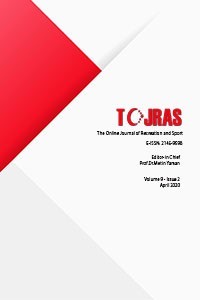EDUCATION LEVEL AND SOCIOECONOMIC STATUS RELATED DIFFERENCES IN REGULAR PHYSICAL ACTIVITY LEVELS OF ADULTS
EDUCATION LEVEL AND SOCIOECONOMIC STATUS RELATED DIFFERENCES IN REGULAR PHYSICAL ACTIVITY LEVELS OF ADULTS
This study aims to investigate the effects of education and socio-economic status on regular physical activity levels in 1350 males and 1350 female participants at the age range of 14-95 years. Turkish version of Physical Activity Stages of Change Questionnaire Cengiz, Asci & Ince, 2010 was used for data collection in different age groups for both genders. Socioeconomic status information composed of monthly household income and final educational level of a participant. Results of this study showed that the mean body height and weight were significantly differentiated depending on male participants’ educational status and monthly income level. There were significant differences in female participants’ body height and body weight depending on their educational status. Only significant difference was observed in the mean of female’s body height depending on monthly income level. The physical activity level of uneducated participants was highest in males and females. Significant negative correlations were observed between physical activity and educational status in males r=-,108, p
Keywords:
Physical activity, Sports Socio-economic status, Education Level,
___
- Çeker, A., Çekin, R. & Ziyagil, M.A. (2015). Stages of exercise behaviour changes in male and females from different age groups. CBU Physical Education and Sports Sciences, 8(1), 11-20.
- Cengiz, C., Asci, F.H. & Ince, M.L. (2010). Exercise stages of Change Questionnaire: Its reliability and validity. Turkiye Klinikleri Journal of Sports Sciences, 2(1): 32-37.
- Chad, K. E., Reeder, B. A., Harrison, E. L., Ashworth, N. L., Sheppard, S. M., Schultz, S. L., ... & Lawson, J. A. (2005). Profile of physical activity levels in community-dwelling older adults. Medicine & Science in Sports & Exercise, 37(10), 1774-1784.
- Choiniere, R., Lafontaine, P. & Edwards, A. C. (2000). Distribution of cardiovascular disease risk factors by socioeconomic status among Canadian adults. Canadian Medical Association Journal, 162(9), 13-24.
- Grzywacz, J.G. & Marks, N.F. (2001). Social inequalities and exercise during adulthood: Toward an ecological perspective. Journal of Health and Social Behavior, 42, 202–220.
- Elmagd, M.A., Tiwari, U., Mossa, A.H., Tiwari, D. (2018). The Effect of Socio-Economic Status on the Sports Barriers’ Perception among Participants and Non-Sports Participants in Higher Education in the UAE. J. Adv. Sport. Phys. Edu..; Vol-1, Iss-4 (Nov-Dec, 2018): 104-110.
- He, X. Z. & Baker, D. W. (2005). Differences in leisure-time, household, and work-related physical activity by race,ethnicity, and education. Journal of general internal medicine, 20(3), 259-266.
- Kaplan, M. S., Newsom, J. T., McFarland, B. H. & Lu, L. (2001).Demographic and psychosocial correlates of physical activity in late life. American journal of preventive medicine, 21(4), 306-312. King, A. C., Castro, C., Wilcox, S., Eyler, A. A., Sallis, J. F. & Brownson, R. C. (2000). Personal and environmental factors associated with physical inactivity among different racial–ethnic groups of US middle-aged and olderaged women. Health psychology, 19(4), 354.
- Schnohr, C., Højbjerre, L., Riegels, M., Ledet, L., Larsen, T., Schultz-Larsen, K. & Grønbæk, M. (2004). Does educational level influence the effects of smoking, alcohol, physical activity, and obesity on mortality? A prospective population study. Scandinavian Journal of Social Medicine, 32(4), 250-256.
- Wagenknecht, L. E., Perkins, L. L., Cutter, G. R., Sidney, S., Burke, G. L., Manolio, T. A. & Hulley, S. B. (1990).Cigarette smoking behavior is strongly related to educational status: the CARDIA study. Preventive medicine, 19(2), 158-169.
- ISSN: 2146-9598
- Yayın Aralığı: Yılda 4 Sayı
- Başlangıç: 2012
- Yayıncı: METİN YAMAN
